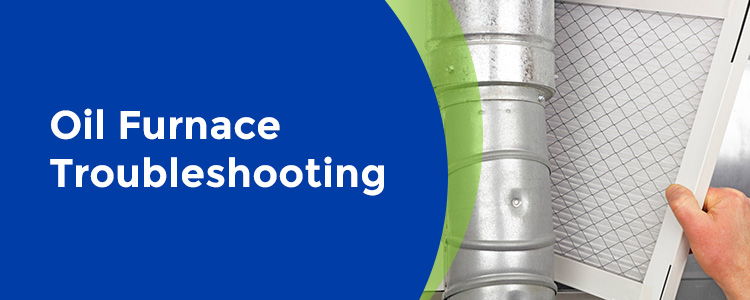
During the fall and winter months, oil furnaces are vital to the comfort of many homeowners in the Northeast. Once the warmer weather has passed, the onslaught of autumn makes it essential to have a functioning furnace. If anything, you should have a furnace that will raise your interior to sufficient temperatures and do so evenly throughout the house with no noises or smell.
Unfortunately, many things can go wrong with an oil furnace, especially if it has sat dormant for six months with no maintenance for twice that time. Common furnace problems are found in the circuit breaker, the filter, the motor, the thermostat and the vents. Warning signs are alight when the furnace makes strange noises, heats insufficiently or shuts off abruptly.
How to Troubleshoot a Furnace
The following 15 furnace troubleshooting tips address the common problems and whether you should handle them yourself or contact a technician.
1. Furnace Fails to Activate — Check to See If the Thermostat Is On
One of the most common oversights homeowners make is turning on the oil furnace but forgetting to turn on the thermostat. Without an active thermostat, the furnace will not receive signals for when to activate. Problems related to the thermostat include that it:
- Is set too low
- Has dead batteries
- Is not plugged in
- Is dirty
- Has the date and time wrong
The furnace should be set 5° above the normal room temperature within your house. That way, the furnace will activate long before your interior drops to the outside temperature on a given winter's day.
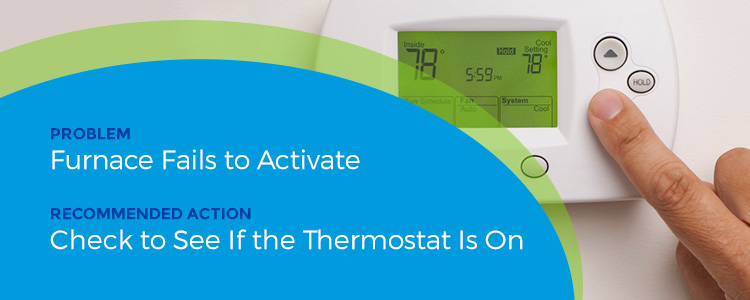
If your thermostat is on, but the furnace fails to produce heat, check to see if the thermostat has an active power source. Some thermostats run on batteries, while others rely on power cords. If your thermostat uses batteries, change them out for new ones. Alternately, check the power cord to verify that it is plugged in. Also, check the fuse to the power supply to ensure the outlet is active.
A thermostat can accumulate dust after several months of dormancy. Open the thermostat to remove any dust or dirt that may be present. If the thermostat has a timer, make sure the day, hour and minute settings are correct.
2. Furnace Fails to Heat — Reset the Circuit Breaker
If the furnace fails to produce heat, make sure you have the thermostat set to "Heat." Adjust the dial to see if you can feel a difference. Then, check the circuit breaker to make sure that the fuses are activated.
In the breaker panel, determine which switch controls the furnace. Is the switch set to the "On" or "Off" position, or is it between the two? If the switch is "Off" or in the middle, switch it to "On" and make sure it stays there. This should reset the breaker and solve the issue. If not, there could be an issue with the wiring or circuitry, in which case you will need to contact a furnace technician.
3. Furnace Heat Is Weak — Clean or Change the Filter
If the furnace fails to generate sufficient heat despite the proper thermostat settings, the problem is likely down to a clogged filter. Ideally, you should clean the filter at least twice each year. Thankfully, filter-cleaning is a relatively easy task that can help improve the performance of your furnace for years to come. The steps involved go as follows:
- Find the Filter: If you are unsure of where to look, inspect the furnace for a panel that resembles a wall grate.
- Inspect the Filter: You can test the condition of the filter in two ways. The first is a sight test that you can perform with a flashlight. Hold the light in front of the filter to see whether there is any shine through. If not, the filter is too dulled and clogged to bother cleaning and should be changed out for a new one. The other test concerns the smell of the filter. If a stench emanates from the filter when the furnace blows air, the time has come for a new filter.
- Replace the Filter: With the furnace shut off, remove the filter and replace it with a fresh duplicate. Take note of the direction in which the filter points prior to removal, as this will be important to know when you attach the replacement. If installed upside down, the filter could fail to trap dust properly and lead to further problems with the furnace.
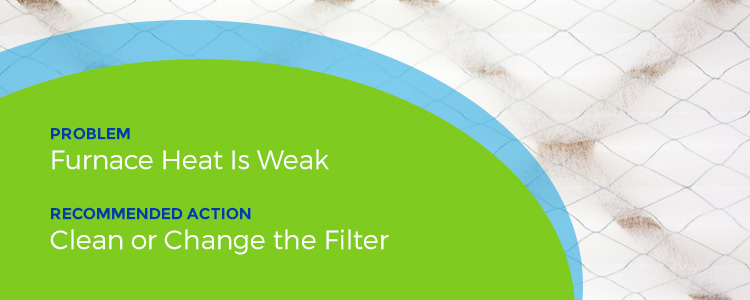
The purpose of the filter is to trap dust and dirt from the air that enters the furnace. If too much dust accumulates, the filter is denied the necessary air to function correctly. Consequently, a dirty filter could reduce the efficiency of your furnace.
4. Furnace Does Not Activate — Check the Furnace-Door Safety Switch
Another issue that can cause a furnace not to operate is an open safety door. Behind the door is the fan and burner, which must always be sealed shut while the furnace is active. Most newer furnaces are programmed with safety switches that prompt the unit to shut off if the door somehow opens during a heating cycle. In such units, the safety switch must be active at all times for the furnace to function.
If the safety switch fails to activate when the door is sealed shut, you will need to replace the safety switch.
5. Obstructed Furnace — Clean the Area That Surrounds the Furnace
If your furnace is situated in your basement, there might be clutter lying around that could hinder its performance. Homeowners often use basements as storage space for old furniture and boxes, so it would be understandable if your furnace is somewhat crowded by these items. However, you shouldn't place things too close to the furnace, especially not anything that could potentially serve as fire hazards.
At the start of each cold season, organize your basement if necessary and reserve a clean, clear area around the furnace. Sweep the basement floor to prevent the kick-up of dust and dirt. If the basement is carpeted, vacuum when necessary.
6. Furnace Emits Poor Heat — Inspect the Burner Flames
Heating problems and furnace failure are often due to faulty burners. Burner failure is typically the result of contaminating elements such as soot and condensation. The easiest way to identify a dirty burner assembly is to note the color emanated by the flames when the furnace is active. If the flames appear blue, you probably have clean burners. If the fire is yellow, you probably have a dirty burner.
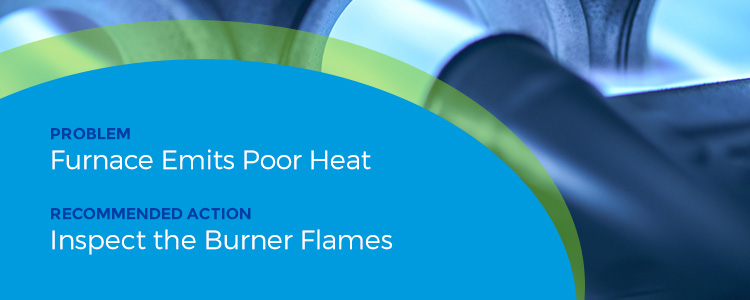
To clean the burner, shut off the furnace and run a vacuum hose over the assembly. While you are at it, run the hose around the blower, as this area can also accumulate dirt and dust. It is best to clean the burner at least once each year, preferably at the start of the cold season. When further complications arise with the burner assembly, it will likely be time to buy a new one.
7. Motor Makes Strange Sounds — Lubricate the Furnace Blower
The purpose of the furnace blower is to disperse heat throughout your living quarters. Each year as the winter season approaches, apply oil to the furnace blower to keep it well lubricated. Here's how to do it:
- Shut off the furnace and open the door to the access panel
- Unfasten the blower motor assembly and remove the motor from its housing
- Apply two or three drops of lubricant in the motor and shaft oil ports
- Refasten the assembly, close the access panel and turn on the furnace
If properly oiled and functioning, the motor blower should not make any strange sounds when active.
8. Blower Runs Non-Stop — Inspect the Limit Switch
The purpose of the limit switch is to prevent the furnace from overworking itself. Once the desired room temperature has been reached, as determined by the thermostat, the blowers should automatically stop for the time being. If the blowers continue on and on even after the heating has stopped, the limit switch has likely tripped.
A properly functioning limit switch should remain closed. If the limit switch fails and the temperature exceeds the proper limits, it will typically create an open circuit where the blower runs nonstop. In cases like these, it is time for a new limit switch.
9. Weak Heat/Failed Pilot Light — Inspect the Ignition or Pilot Control
One of the critical differences between newer and older oil furnaces is that modern ones are usually equipped with electronic control, which allows the unit to work without an ongoing flame. Older furnaces, by contrast, are mostly equipped with pilot lights. Either way, a faulty ignition or pilot control could signal problems with your furnace.
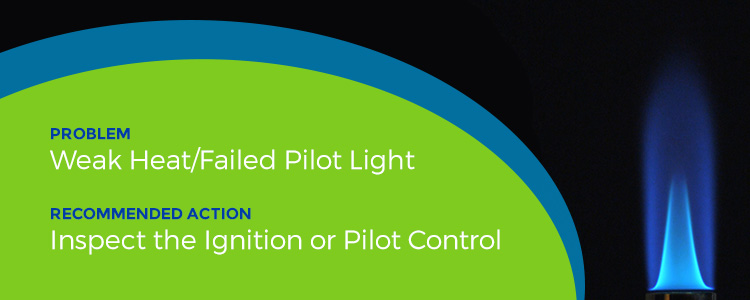
If the ignition malfunctions, the furnace is liable to generate only weak heat at best. Likewise, a pilot light will easily flicker out if the system becomes ruptured or clogged. To pinpoint problems in these areas, flip off the power switch and turn the unit back on to reset the ignition. Then, switch off the power and check the heating element. If cracks or damage are apparent on the heating element, the igniter will have to be replaced. Be careful not to make physical contact with the heating element.
If problems are apparent, contact your trusted local furnace technician.
10. The Furnace Cycles On and Off Abruptly — Check the Filter
If the furnace switches off just seconds after cycling on, the problem could be one of many issues, including a dirty air filter. If the filter hasn't been cleaned or changed in a while, the furnace might be deprived of sufficient inlet air to function correctly.
A filter is an easy part to clean or replace, but it might not solve the problem at hand. If your furnace continues to switch on and off despite the presence of a clean filter, the unit might have a blown motor or broken belt. In either case, you will need to contact your nearest trusty furnace technician.
11. Furnace Fails to Blow — Inspect the Blowers and Lights
If the furnace fails to blow air, check the blower and clear away any dust or dirt that might be present. Note the color of the flashing light of your furnace — is it green or red? If the light is red, that would indicate a performance issue that should be reported to a technician. If no light flashes, the problem could be rooted in several areas, such as the motor, the control board, the thermostat or the run capacitor. In any case, the furnace will need to be serviced by a professional.
12. Furnace Runs Louder Than Normal — Inspect the Ductwork
A good furnace should run smoothly at a low, consistent volume, free of noise. If your furnace runs more loudly than normal, there is probably an issue with the ductwork, which might also ping or pop as the metal expands and contracts. If the duct lacks insulation, air passing through the ductwork could cause the system to be noisier than usual. Consider adding insulation to the ductwork to soften the noise.
Strange noises are often due to insufficient oil in the motor lubrication port or a maladjusted pilot light. If the system rattles, rumbles or squeaks during cycles, there is probably an issue with something in the furnace itself, such as the motor, the belts or the burner. Furnace noises typically correlate as follows:
- Squealing: A worn or torn motor/fan belt
- Rattling: Loose encasement panels
- Grinding: Worn motor bearings
If loose encasement panels cause the noise, you can usually fix the problem with some basic refastening. Problems that involved the belts or bearings are best handled by a furnace technician.
13. Uneven Heat Dispersion — Clear the Vents
If heat disperses more generously in certain rooms more than others, you should first check for blocked vents. Funny enough, many homeowners play little mind to the location of vents when arranging furniture.
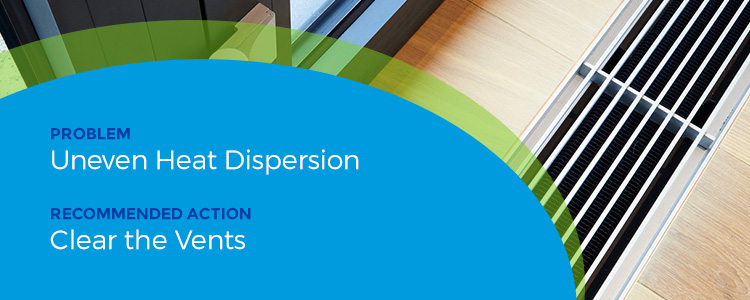
In the parts of your house where the heat feels weak, double check the lower walls and floor edges to see if any vents are partially obstructed. Remember to check behind chairs, shelves and other large pieces of furniture for a blocked vent. Move your furniture around if necessary to clear the opening for each vent in your house.
14. Obstructed External Vents — Clear Away Leaves and Debris
If your furnace is situated outside, check the intake and exhaust vents each month during the fall and winter months. As autumn weather takes hold, the vents can easily get clogged with leaves, debris and foliage. The more clogged these vents become, the harder the furnace must work to perform its job correctly.
15. The Furnace Sputters Out — Check the Fuel Supply
Check the fuel and oil level to ensure the furnace has enough juice to function. Inspect the tubes to verify that fluids are moving properly through the system. Also, check the floor surrounding the furnace for the presence of oil leaks. If oil stains have formed on the ground, the system has a leak. Contact a furnace technician for help on this matter.
Choose Smart Touch Energy for Your Furnace Needs
In the northeastern United States, many homes rely on oil furnaces for warmth during the colder months. Smart Touch Energy provides heating oil for homeowners in Massachusetts, Connecticut, New Hampshire, Maine, New Jersey, New York, Pennsylvania, Maryland, Rhode Island and Delaware. Browse our services and contact us today for more information.




